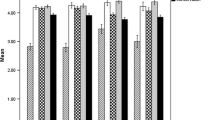Abstract
The purpose of this study was to clarify contradictory findings concerning the social status of aggressive youngsters. This was undertaken by dividing kindergarten boys into either Aggressive [A] or Aggressive/Withdrawn [A/W] groups, as proposed by Ledingham [1981]. Both groups were found to be high on peer-nominated rejection, but the A group was also high on peer-nominated popularity while the A/W group was low. Similarly, both groups were observed to be high in negative peer interactions, but the A group was also high in positive interactions. It was noted that valuable information regarding the social status and social behavior of aggressive youngsters would be lost if such subgrouping is not undertaken. The relationship between Ledingham's categorizations and others reported in the literature was discussed.
Similar content being viewed by others
References
Bell, R. Q., & Harper, L. V. (1977).Child effects on adults. Hillsdale, New Jersey: Erlbaum.
Cohen, J. (1960). A coefficient of agreement for nominal scales.Educational and Psycho- logical Measurement, 20, 37–46.
Coie, J. D., Dodge, K. A., & Coppotelli, H. (1982). Dimensions and types of social status.Developmental Psychology, 18, 557–570.
Conners, C. K. (1969). A teacher rating scale for use in drug studies with children.American Journal of Psychiatry, 126, 152–156.
Cowen, E. L., Pederson, A., Babigian, H., Izzo, L. D., & Trost, M. A. (1973). Long-term follow-up of early detected vulnerable children.Journal of Consulting and Clinical Psychology, 41, 438–446.
Crowther, J. H., Bond, L. A., & Rolf, J. E. (1981). The incidence, prevalence, and severity of behavior disorders among preschool-age children in day care.Journal of Abnormal Child Psychology, 9, 23–42.
Dodge, K. A., Coie, J. D., & Brakke, N. P. (1982). Behavioral patterns of socially rejected and neglected preadolescents: The roles of social approach and aggression.Journal of Abnormal Child Psychology, 10, 389–410.
Glow, R. A., & Glow, P. H. (1980). Peer and self-rating: Children's perception of behavior relevant to hyperkinetic impulse disorder.Journal of Abnormal Child Psychology, 8, 471–490.
Goldman, J. A., Corsini, D. A., & deUrioste, R. (1980). Implications of positive and negative sociometric status for assessing the social competence of young children.Journal of Applied Developmental Psychology, 1, 209–220.
Gottman, J., Gonso, J., & Rasmussen, B. (1975). Social interaction, social competence, and friendship in children.Child Development, 46, 709–718.
Green, K. D., Beck, S. J., Forehand, R., & Vosk, B. (1980). Validity of teacher nominations of child behavior problems.Journal of Abnormal Child Psychology, 8, 397–404.
Greenwood, C. R., Walker, H. M., Tood, N. M., & Hops, H. (1979). Selecting a cost-effective screening measure for the assessment of preschool social withdrawal.Journal of Applied Behavior Analysis, 12, 639–652.
Hartmann, D. P. (1977). Considerations in the choice of interobserver reliability estimates.Journal of Applied Behavior Analysis, 10, 103–116.
Hull, C. H., & Nie, N. H. (1981).SPSS update 7-9. New York: McGraw-Hill.
Janes, C. L., Hesselbrock, V. M., Myers, D. G., & Penniman, J. H. (1979). Problem boys in young adulthood: Teachers' ratings and twelve-year follow-up.Journal of Youth and Adolescence, 8, 453–472.
Ledingham, J. E. (1981). Developmental patterns of aggressive and withdrawn behavior in childhood: A possible method for identifying preschizophrenics.Journal of Abnormal Child Psychology, 9, 1–22.
Ledingham, J. E., Younger, A., Schwartzman, A., & Bergeron, G. (1982). Agreement among teacher, peer, and self-ratings of children's aggression, withdrawal, and likability.Journal of Abnormal Child Psychology, 10, 363–372.
Lesser, G. S. (1959). The relationship between various forms of aggression and popularity among lower-class children.Journal of Educational Psychology, 50, 20–25.
Loney, J., & Milich, R. (1982). Hyperactivity, inattention, and aggression in clinical practice. In M. Wolraich & D. K. Routh (Eds.),Advances in developmental and behavioral pediatrics (Vol. 2, pp. 113–147). Greenwich, Connecticut: JAI Press.
Marshall, H. R., & McCandless, B. R. (1957). A study in prediction of social behavior of preschool children.Child Development, 28, 149–159.
Milich, R., & Landau, S. (1982). Socialization and peer relations in hyperactive children. In K. D. Gadow & I. Bialer (Eds.),advances in learning and behavioral disabilities Vol. 1, pp. 283–339). Greenwich, Connecticut: JAI Press.
Milich, R., Landau, S., Kilby, G., & Whitten, P. (1982). Preschool peer perceptions of the behavior of hyperactive and aggressive children.Journal of Abnormal Child Psychology, 10, 497–510.
Nuechterlein, K. H. (1983). Signal detection in vigilance task and behavioral attributes among offspring of schizophrenic mothers and among hyperactive children.Journal of Abnormal Psychology, 92, 4–28.
Olweus, D. (1978).Aggression in the schools. Washington: Hemisphere.
Pekarik, E. G., Prinz, R. J., Liebert, D. C., Weintraub, S., & Neale, J. M. (1976). The Pupil Evaluation Inventory: A sociometric technique for assessing children's social behavior.Journal of Abnormal Child Psychology, 4, 83–97.
Pelham, W. E. (1982). Childhood hyperactivity: Diagnosis, etiology, nature and treatment. In R. Gatchel, A. Baum, & J. Singer (Eds.)Behavioral medicine and clinical psychology: Overlapping disciplines (pp. 261–327). Hillsdale, New Jersey: Erlbaum.
Rieder, R., & Nichols, P. (1979). Offspring of schizophrenics. III: Hyperactivity and neurological soft signs.Archives of General Psychiatry, 36, 665–674.
Roff, M. (1961). Childhood social interactions and young adult bad conduct.Journal of Abnormal and Social Psychology, 63, 333–337.
Roff, M. (1963). Childhood social interactions and young adult psychosis.Journal of Clinical Psychology, 19, 152–157.
Ullman, C. A. (1957). Teachers peers and tests as predictors of adjustment.Journal of Educational Psychology, 48, 257–267.
West, D. J., & Farrington, D. P. (1973).Who becomes delinquent? London: Heinemann.
Author information
Authors and Affiliations
Additional information
This research was supported in part by NIH grant No. 32992 to the first author.
Rights and permissions
About this article
Cite this article
Milich, R., Landau, S. A comparison of the social status and social behavior of Aggressive and Aggressive/Withdrawn boys. J Abnorm Child Psychol 12, 277–288 (1984). https://doi.org/10.1007/BF00910668
Revised:
Issue Date:
DOI: https://doi.org/10.1007/BF00910668




